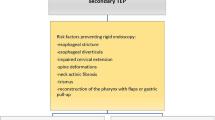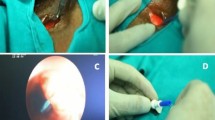Abstract
Background
Functional speech rehabilitation after total laryngectomy remains one of the most challenging issues in head and neck multidisciplinary care. Tracheoesophageal puncture for voice prosthesis insertion performed as a secondary procedure with a rigid esophagoscope and trocar can be technically difficult in certain patients due to post-treatment cervical abnormalities, such as reduced hyperextension, stenosis, and trismus.
Methods
This study presents an improved method of secondary tracheoesophageal prosthesis insertion using a flexible endoscope in association with a plastic pliable overtube to keep the virtual esophageal lumen open. By this method, the puncture can be performed easily and safely with the avoidance of unexpected lesions.
Results
From 2005 to 2015, 12 (16,9%) out of 71 patients who underwent secondary voice prosthesis placement at our institution required this alternative technique due to anatomical alterations that hindered the execution of the procedure following the standard technique.
Conclusion
The procedure was successfully performed in all patients with no related complications.
Similar content being viewed by others
Background
The gold standard voice rehabilitation technique for restoration of oral communication after total laryngectomy is the placement of a valve voice prosthesis (VP) for tracheoesophageal voice [1, 2]. The tracheoesophageal fistula can be made either primarily (early during the total laryngectomy) and secondary (late). The conventional technique for secondary placement of a VP uses a rigid esophagoscope and a trocar to create a tracheoesophageal fistula [3]. When the conventional procedure is technically difficult or even impossible due to post-treatment abnormalities, such as reduced neck extension, pharyngoesophageal stenosis, and trismus, performing tracheoesophageal puncture (TEP) with a flexible endoscope is a solution described in the literature [4, 5]. Nevertheless in our attempts to reproduce this technique, the puncture proved to be quite difficult because keeping the esophageal lumen patent and structured was impossible and created the risk of development of lesions on the posterior wall of the esophagus. Given this difficulty, we proposed the use of a transparent pliable plastic tube (the inner part of the wired overtube), which, maintained the structure of the esophageal wall to enable better visualization of the puncture site and protected the posterior wall of the esophagus, thereby avoiding accidents during the procedure.
Methods
This improvement to the previously described TEP technique for difficult cases consists of the use of a flexible endoscope and a plastic, transparent and pliable overtube that covers the endoscope during its passage through the pharynx and the esophagus and is maintained at the puncture site. The main role of this plastic tube is to maintain the esophageal lumen (which is virtual) in an open and structured state to enable better visualization and facilitate the formation of the puncture while ensuring protection of the posterior wall of the esophagus against needle accidents, such as lacerations and perforations (Fig. 1). The puncture was performed by the surgeon using a 14 gauge needle (Fig. 1- endoscopic view). With the flexible endoscope introduced through the plastic overtube, we could observe the portion of the needle exposed in the esophageal lumen after it had perforated the posterior wall of the trachea and the anterior wall of the esophagus and had transfixed the overtube itself. After the introduction of the needle/catheter, the mandrill was gripped and removed, and a 0,035 inch guidewire was introduced until it was visible within the overtube. The progression of this wire can be visualized by the endoscope until it exits through the oral cavity (from the tracheostomy). If this progression does not occur as expected, the wire can be gripped using biopsy forceps while keeping the overtube in place for protection against mucosal lacerations. Finally, the overtube was removed. With the pliable guidewire in position, we proceeded to perform the retrograde dilation of the newly made tracheoesophageal fistula with the Savary-Gilliard® dilator number 5 (Fig. 2), which forms a tracheoesophageal fistula that is perfectly fitted to the Provox2®. We provide with the Savary-Gilliard ® dilator a millimeter scale, which allows for the selection of the correct VP size. Subsequently, the pliable end of the guidewire is attached to the Provox2® blue plastic introducer (the introducer guide referred to as the Provox® guidewire in the retrograde technique) through an “adapted knot” (Fig. 3- detail). The set (pliable guidewire and the Provox introducer guidewire) is pulled up until it reaches the oral cavity, and it is finally positioned for classic retrograde introduction of the Provox2® (Fig. 3). The Provox2® is attached to the tip of the introducer guidewire and placed in the tracheoesophageal fistula under endoscopic visualization.
Results
From Jan. 2005 to Dec. 2015, 71 secondary TEP procedures were performed at AC Camargo Cancer Center, São Paulo, Brazil. Of those 51 patients, 12(16,90%) had anatomical post-treatment alterations that hindered the performance of the conventional method of the secondary placement procedure (using a trocar and rigid esophagoscope). The procedure was easily performed in these 12 patients. Patient data is shown in Table 1. Speech was obtained in all patients. The mean time to first VP replacement was 79 days.
Discussion
In this cohort, almost 17% of the patients who were referred for secondary Provox placement presented with technical difficulties that did not allow implantation using the classical technique. This percentage suggests that improvements in the alternative Provox placement technique with the aid of a flexible endoscope should be implemented and encouraged. Additionally, complications of this procedure due to difficulty in performing the puncture, such as false track formation and mediastinitis, should be addressed.
This study proposed the use of a plastic tube (inner part of the wired overtube) to assist in secondary tracheoesophageal puncture for the first time, and TEP was successfully and easily performed in all 12 patients included in this study using this new method. Because the overtube is manufactured with flexible and transparent plastic, it is able to keep the esophageal lumen patent without any mucosal injury or other esophageal injuries. In addition to the ease with which it can be inserted with the endoscope, the overtube allows for the performance of TEP under direct view of the flexible esophagoscope, and also allows the surgeon to determine the best site for TEP. Dilation of the fistulous tract with the Savary dilator number 5 was performed easily and without complications because the probe was guided by the guidewire with both ends of the probe secured (in the oral cavity and the tracheostoma). The plastic overtube is a simple and cheap device that is available at almost all therapeutic endoscopy services.
This technique is easy to apply, low complication and could be routinely used as a standard technique for placement of the VP.
Conclusions
The described technique with a pliable plastic overtube and flexible esophagoscope was demonstrated to be a good alternative for assistance of tracheoesophageal puncture in laryngectomized patients for whom the standard technique was not feasible.
References
Op de Coul BM, Hilgers FJ, et al. A decade of postlaryngectomy vocal rehabilitation in 318 patients: a single Institution's experience with consistent application of provox indwelling voice prostheses. Arch Otolaryngol Head Neck Surg. 2000;126(11):1320–8.
Vartanian JG, Carrara-de-Angelis E, Kowalski LP. Practice of laryngectomy rehabilitation interventions: a perspective from South America. Curr Opin Otolaryngol Head Neck Surg. 2013;21(3):212–7.
Boscolo-Rizzo P, Zanetti F, Carpene S, Da Mosto MC. Long-term results with tracheoesophageal voice prosthesis: primary versus secondary TEP. Eur Arch Otorhinolaryngol. 2008;265:73–7.
Padhya TA, Athavale SM, et al. An alternative approach for secondary tracheoesophageal puncture in the difficult laryngectomy neck. Laryngoscope. 2008;118(2):266–9.
Morrison MP, Chheda NN, Postma GN. The tough tracheoesophageal puncture. Am J Otolaryngol. 2012;33(1):113–5.
Acknowledgements
Not applicable.
Funding
Supported by CIPE – International Center for Research AC Camargo Cancer Center, São Paulo, Brazil.
Availability of data and materials
All data generated or analysed during this study are included in this published article.
Author information
Authors and Affiliations
Contributions
All the authors performed surgical procedures. AGP, CZS and AMS wrote and reviewed the article. All authors read and approved the final manuscript.
Corresponding author
Ethics declarations
Ethics approval and consent to participate
This study was approved by the ethics committee in research on human beings of the Hospital AC Camargo, São Paulo, Brazil on July 16, 2015 under reference number EC 30/15.
Consent for publication
Not applicable.
Competing interests
The authors declare that they have no competing interests.
Publisher’s Note
Springer Nature remains neutral with regard to jurisdictional claims in published maps and institutional affiliations.
Rights and permissions
Open Access This article is distributed under the terms of the Creative Commons Attribution 4.0 International License (http://creativecommons.org/licenses/by/4.0/), which permits unrestricted use, distribution, and reproduction in any medium, provided you give appropriate credit to the original author(s) and the source, provide a link to the Creative Commons license, and indicate if changes were made. The Creative Commons Public Domain Dedication waiver (http://creativecommons.org/publicdomain/zero/1.0/) applies to the data made available in this article, unless otherwise stated.
About this article
Cite this article
Pelosof, A.G., Seraphim, A.M., Sztokfisz, C.Z. et al. Alternative technique in secondary tracheoesophageal puncture using flexible endoscope and overtube in patients with difficult post-laryngectomy abnormalities. Appl Cancer Res 37, 42 (2017). https://doi.org/10.1186/s41241-017-0048-2
Received:
Accepted:
Published:
DOI: https://doi.org/10.1186/s41241-017-0048-2







